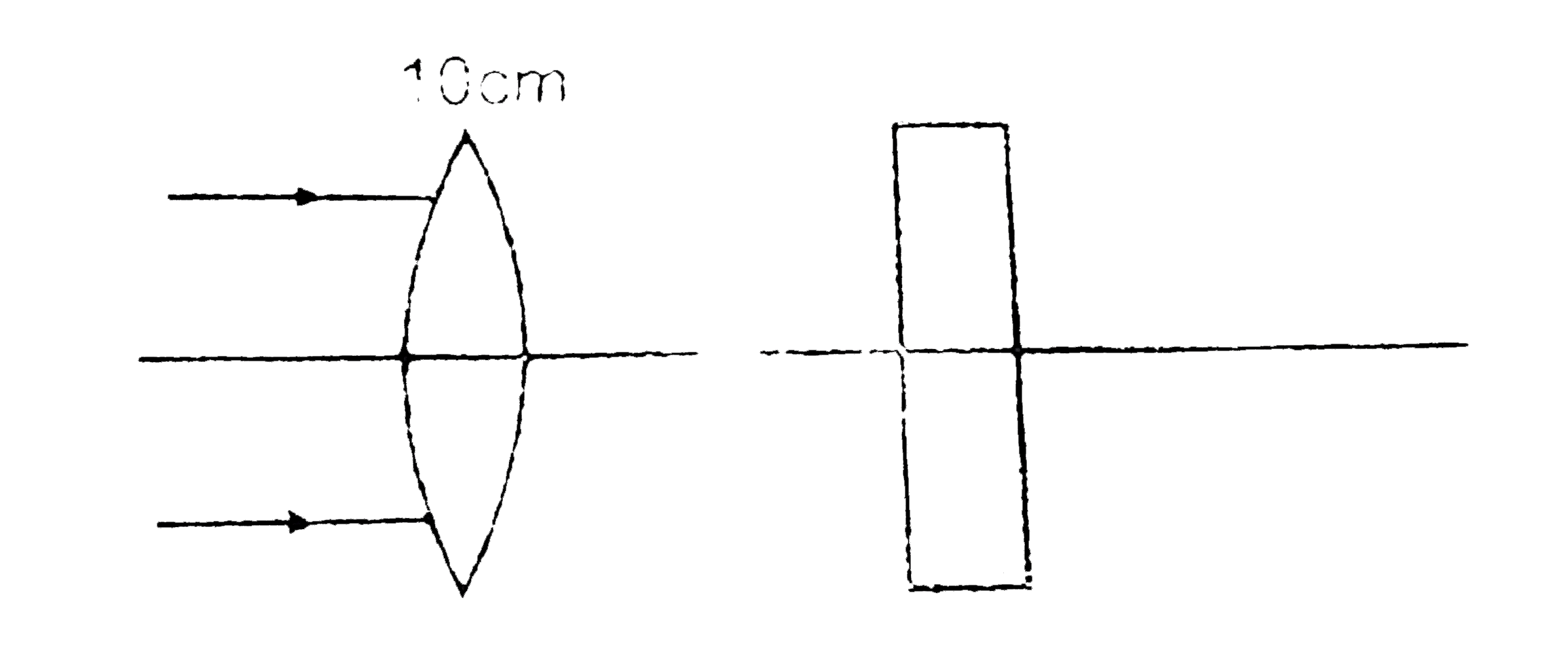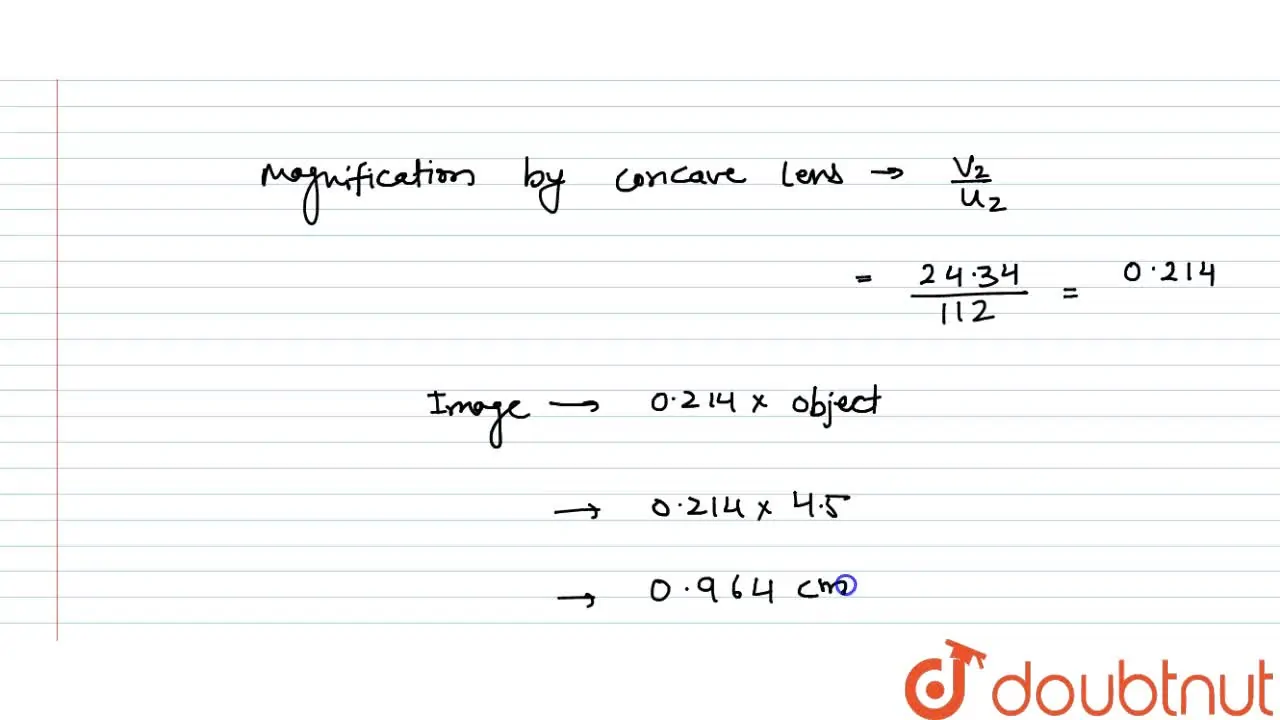a) Determine the effective focal length of the combination of the two lenses in Exercise, if they are placed 8.0cm apart with their principal axes coincident. Does the answer depend on which side of the combination a beam of paralel light is incident? Is the notions of effective focal length of this system useful at all?
b) An object 1.5 cm in size is placed on the side of the convex lens in the arrangement a) above. The distance between the object and the convex lens is 40cm. Determine the magnification produced by the two-lens system, and the size of the image.
Focal length of the convex lens, f1=30 cm
Focal length of the convex lens, f2=−20cm
Distance between the two lenses, d=8.0cm
a) Whenhte parallel beam of light is incident on the convex lens first.
According to the lens formula, we have:
1vi−1u1=1f1
Where, u1=object distance =∞
v1= image distance
1v1=130−1∞=130
∴v1=30cm
the image will act as a virtual object for the concave lens.
Applying lens formula to the concave lens, we have,
1v2−1u2=1f2
Where, u2= object distance
(30−d)=30−8=22cm
v2 = Image distance
1v2=122−120=10−1122=−1220
∴v2=−220cm
The parallel incident beam appears to diverge from a point that is (220−d2=220−4) from the center of the combination of the two lenses.
ii) When the parallel beam of light is incident, from the left, on the concave lens first:
According to the lens formula, we have:
1v2−1u2=1f2
1v2=1f2+1u2
Where, u2= object distance = =−∞
v2 = Image distance
1v2=1−20+1−∞=−120
∴v2=−20cm
The image will act as a real object for the convex lens.
Applying lens formula to the convex lens, we have:
1v1−1u1=1f1
Where, μ1=Object distance
−(20+d)=−20+8=−28cm
v1 = image distance
1v1=130+1−28=14−15420=−1420
∴v2=−420cm
Hence, the parallel incident beam appear to diverge from a point that is (420−4) 416 cm from the left of the center of the combination at which the parallel beam of light is incident. The nottion of effective focal lengh does not seem to be useful for this combination.
b) Height of the image, h1=1.5cm
Object distance from the side of the convex lens, μi=−40cm
|μ1|=40cm
According to the lens formula,
1v1−1u1=1f1
Where, v1 = Image distance
1v1=130+1−40=4−3120=1120)
∴v1=20cm
m=v|μ1|
Magnification,
=12040=3
Hence, the magnification due to the convex lens is 3.
the image formed by the convex lens acts as an object for the concave lens. According to the lens formula.
1v2−1u2=1f2
Where, μ2 = Objedt distance,
=+(120-8) = 112cm
v2=−224092cm
m′=∣∣∣v2v1∣∣∣
Magnification ,
=224092×11(112)=2092
Hence, the magnification due to the concave lens is (2092)
The magnification produced by the combination of the two lenses is calculated as: m×m′
=3×2092=6092=0.652
The magnification of the combination is given as:
h2h1=0.652
h2=0.652×h1
where, h1=object size = 1.5cm
h2=size of the image
∴h2 = 0.652×1.5=0.98cm
Hence, the height of the image is 0.98 cm.
Related Playlists
- BOOK - NCERTCHAPTER - RAY OPTICS AND OPTICAL INSTRUMENTSEXERCISE - Exercise32videos
RAY OPTICS AND OPTICAL INSTRUMENTS
- BOOK - NCERTCHAPTER - NUCLEIEXERCISE - Exercise31videos
NUCLEI
- BOOK - NCERTCHAPTER - SEMICONDUCTOR ELECTRONICS MATERIALS DEVICES AND SIMPLE CIRCUITSEXERCISE - Exercise15videos
SEMICONDUCTOR ELECTRONICS MATERIALS DEVICES AND SIMPLE CIRCUITS
Similar Questions
(a) Determine the 'effective focal length' of the combination of the two lenses in Exercise 9.10, if they are placed 8.0 cm apart with their principal axes coincident. Does the answer depend on which side of the combination a beam of parallel light is incident ? Is the notion of effective focal length of this system useful at all ? <> (b) An object 1.5 cm in size is placed on the side of the convex lens in the arrangement (a) above. The distance between the object and the convex lens is 40 cm. Determine the magnification produced by the two-lens system, and the size of the image.
View Solutiona) Determine the effective focal length of the combination of the two lenses in Exercise, if they are placed 8.0cm apart with their principal axes coincident. Does the answer depend on which side of the combination a beam of paralel light is incident? Is the notions of effective focal length of this system useful at all?
b) An object 1.5 cm in size is placed on the side of the convex lens in the arrangement a) above. The distance between the object and the convex lens is 40cm. Determine the magnification produced by the two-lens system, and the size of the image.View Solutiona) Determine the effective focal length of the combination of the two lenses in Exercise, if they are placed 8.0cm apart with their principal axes coincident. Does the answer depend on which side of the combination a beam of paralel light is incident? Is the notions of effective focal length of this system useful at all?
b) An object 1.5 cm in size is placed on the side of the convex lens in the arrangement a) above. The distance between the object and the convex lens is 40cm. Determine the magnification produced by the two-lens system, and the size of the image.View SolutionThe focal length of the combination of two thin lenses in contact is 80 cm. If the focal length of one lens is -20 cm, what is the power of the other lens ?
View SolutionA converging lens of focal length 12 cm and a diverging mirror of focal length 7.5 cm are placed 5.0 cm apart with their principal axes coinciding. Where should an object be placed so that its image falls on itself ?
View SolutionA diverging lens of focal length 20 cm and a converging lens of focal length 30 cm are placed 15 cm apart with their principal axes coinciding. Where should an object be placed on the principal axis so that its image formed at infinity ?
View SolutionA parallel beam of light is incident on a lens of focal length 10 cm. A parallel slab of refractive index 1.5 and thickness 3 cm is placed on the other side of the lens. Find the distance of the final image from the lens.
 .View Solution
.View SolutionTwo thin equiconvex lenses each of focal length 0.2 m are placed coaxially with their optic centres 0.5m apart. Then find the focal length of the combination.
View SolutionFocal length of combination of two thin lenses is 1 m. Calculate the power of one lens if the focal length of other lens is 30 cm.
View SolutionA convex lens of focal length 20 cm and a concave lens of focal length 10 cm are placed 10 cm apart with their principal axes coinciding. A beam of light travelling parallel to the principal axis and having a beam diameter 5.0 mm, is incident on the combination. Show that the emergent beam is parallel to the incident one. Find the beam diameter of the emergent beam.
View Solution


